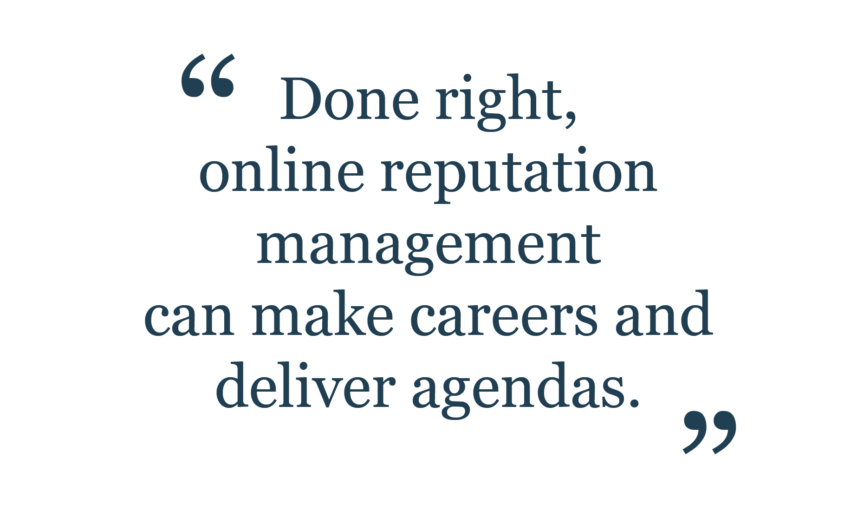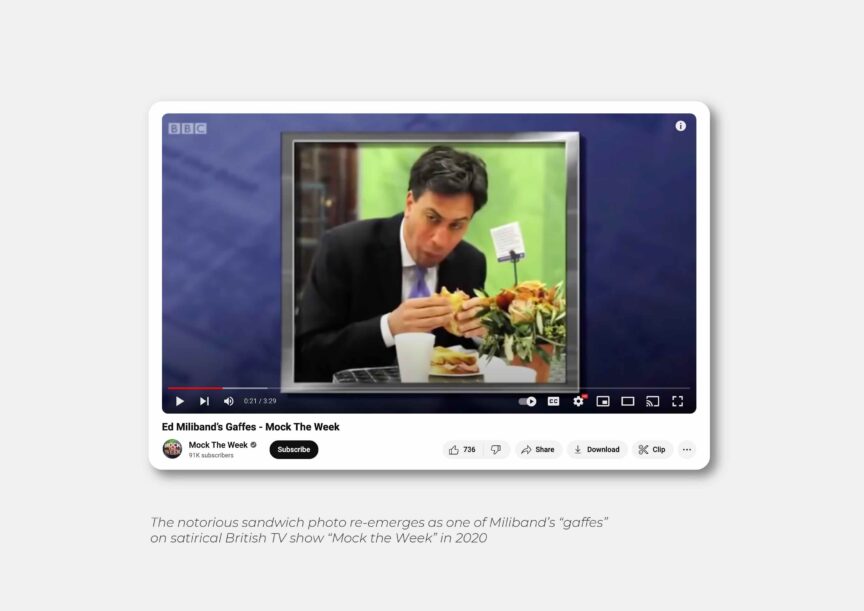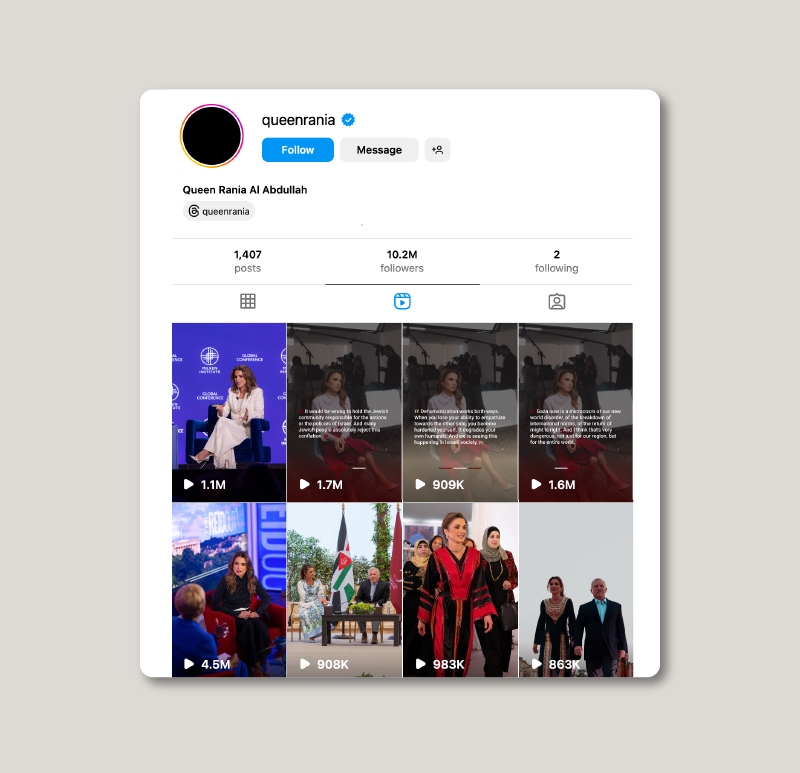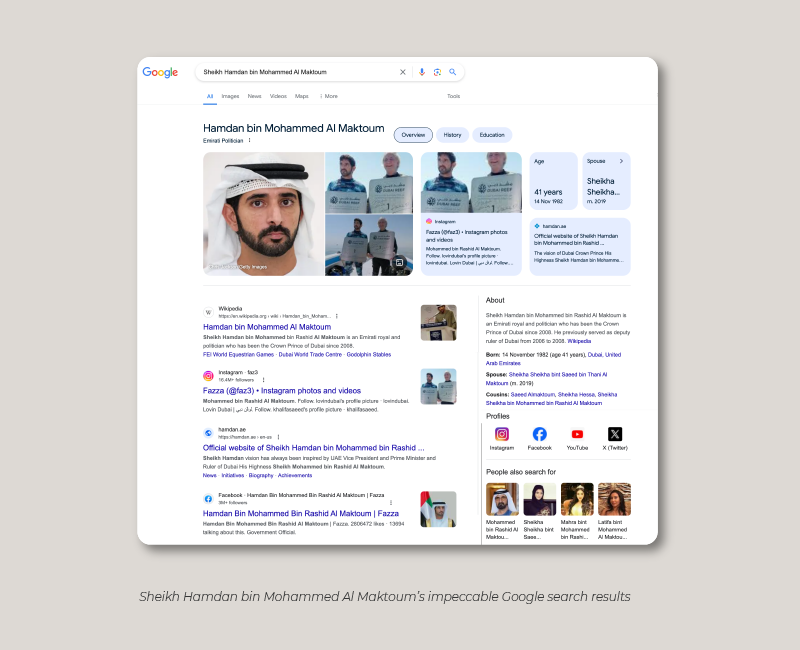Own your reputation:
Master online before it masters you
By Alan Griffin and Dalia Aljurf
The internet is forever
Google “Ed Miliband sandwich” and you will get over 110 000 hits, the vast majority of them featuring an unflattering 2014 photo of the UK politician struggling to get his jaws around a snack. Instant viral meme, front-page headlines, countrywide mockery – some even say the awkward shot contributed to Labour’s loss at the next general election. And the internet is forever: those photos are never going away.
In contrast, Argentina’s political upstart and prolific poster Javier Milei knows how to work an online crowd. Days before the presidential election in November 2023, Milei was in trouble. In a televised debate with his far more experienced opponent, he seemed to flail, and many experienced observers predicted a humiliating defeat for the flamboyant, combative politician. But social media told a different story: online, Milei’s followers were roused by what they saw as a bold challenge to the powers that be – and he went on to take a record-breaking 56% of the vote in an upset victory.1 The lesson is clear: artful posting can get you far these days, perhaps further than traditional media.

Take control of your message
Any public figure’s reputation can be made or lost in moments online. Done right, online reputation management (ORM) can make careers and deliver agendas. Equally, it can blow up in your face – as Miliband discovered to his cost – with personal, political, and sometimes global repercussions. But the biggest risk is inaction: no modern government can afford to ignore the power of ORM to build relationships with citizens and serve them more effectively.
Online risk is compounded by the special constraints and pressures on public officials. These are busy people with heavy responsibilities. Time, attention and resources can be in limited supply. Whatever they do falls under intense scrutiny: political opponents, internal adversaries, the media and the public are waiting to pounce on the slightest error. All this plays out against the shifting diplomatic landscape: actions reverberate internationally.
In this tough environment, it helps to remember that, unlike traditional media, a digital channel is under your control. It’s your own personal media operation and importantly, you decide what’s in it. This also means that it’s your responsibility. You may get a team of skilled advisors to create an online presence, but it’s up to you to maintain it – and handle things if a post misfires or a crisis hits.
And there’s no dodging it: social media has become compulsory, an essential part of day-to-day government practice. Or as Javier Milei puts it: “I use social media at breakfast, lunch and at night.”2
Pick your approach
Different leaders have very different approaches – it’s not one-size-fits-all. ORM models can be chosen and tweaked to match a leader’s schedule, resources and personality. Prominent global examples fall on a sliding scale of risk, reward and engagement.

The DIY approach: high personal engagement, high risk
This works best for relatable individuals who are familiar with digital platforms, have time and are comfortable with personal engagement. Managing their own profiles and posts, leaders are responsive to followers and happily share glimpses of their daily life.
Geordin Hill-Lewis, Mayor of Cape Town, South Africa, is a case in point – he uses a daily posting strategy to reach his receptive audience. As Hill-Lewis has remarked, residents “want to see us at work, and be able to trust that we see them and care … We respond to residents’ queries and concerns on social media. We give them insight into the day-to-day functioning of the mayor’s office and the city at large.”3 This model is simple and effective; time management, consistency and emotional control are key to success.
On a larger scale, the US congresswoman Alexandria Ocasio-Cortez (“AOC”) has over eight million followers on Instagram and over 13 million on X (formerly Twitter) – bigger followings than either the New York Post or The Guardian. Consistently active on social media, deploying multimedia and canny personal storytelling, she’s built a reputation among her followers for being authentic and approachable. Her “owned media” is integral to her campaign strategy and is often covered by the traditional press.4 While she’s expanded her social media team in recent years, she retains the personal touch.
- The rewards: You’re in control of your own agenda, strategy and success. Done well, the messaging appears authentic, sincere and engaging – and doesn’t cost much to produce. The biggest pay-off is your audience’s loyalty and trust, and the online buzz that results from high visibility and engagement.
- The risks: This requires significant daily time and effort, and you’re exposed to risk if you have an off day or impetuous moment. A bold presence can be polarising, attracting haters just as committed as supporters.
The advisor approach: moderate engagement, moderate risk
This approach blends DIY with reliance on a close advisor such as a chief of staff to mediate with the public. Done well, this approach can provide a good balance of authenticity and authority. It lets a leader add a personal touch while giving them more time to focus on additional duties, confident that their ORM is in safe hands.
For example, Queen Rania of Jordan (18 million followers on Facebook, 10 million on X) presents a polished, visually appealing presence that positions her as an authentic leader who cares deeply for the country and region. She takes sides passionately – while scrupulously hewing to official policies.5 “People say I am very unconventional for being so present online, but the world is changing. I think the theme of our community is openness and transparency,” she has said.6
It’s clear that the queen’s image is well managed by her team. She does not engage in the kind of back-and-forth with followers that might expose her and undermine her regal aura. Tellingly, with more than ten million Instagram followers, she herself follows only two accounts, the Royal Hashemite Court and HRH the Crown Prince of Jordan, with which she engages frequently, further strengthening the digital ecosystem of the Hashemites
- The rewards: ORM is contained within a small group of advisors who are very aligned with the leader’s tone and agenda. This approach can convey personality and intimacy in a carefully controlled and bounded way, while giving the leader time to pursue other duties.
- The risks: It can take longer to produce content than doing it alone. Conflicting views within a team can also lead to inconsistent messaging. This route, while it can buff an image to a high shine, has less power to build a sense of authentic relationship with followers.
The official approach: low personal engagement, low risk
This approach is prevalent with senior, very busy and/or well-resourced leaders. It does not require much personal responsiveness, allowing the leader to get on with other duties with the comprehensive support of a professional team that can deliver complex messaging at scale.
Take, for example, Sheikh Hamdan bin Mohammed Al Maktoum, the Crown Prince of Dubai. Sheikh Hamdan is a hugely popular Emirati figure and is very active on Instagram (16,3 million followers – more than the population of the UAE), X (4,8 million), LinkedIn and Facebook (around 3 million each). His social-media feeds include posts of him engaging in elite sports interspersed with sober affairs of state, messages to the nation and his own poetry. While he occasionally posts informal images of his children and hobbies, the tone is not so much intimate as highly curated. It is clear that he has access to vast media resources, evidenced in slick videos produced with support from Brand Dubai and other government entities. You can even download a “Hamdan” app, developed by the Dubai Media Office, which “enables the public to have direct connection to Sheikh Hamdan’s news.”7
Sheikh Hamdan’s overwhelmingly positive online mentions also indicate a media operation with impressive search engine optimisation (SEO) skills and strong control of the narrative: a Google search puts his website and social media accounts up front, along with a glowing Wikipedia entry and various reverential media mentions – “dashing crown prince” and “Insta-famous poet, politician, daredevil and animal-lover” are typical descriptions.8
At the far end of this engagement scale lies a leader like Prime Minister Fumio Kishida of Japan. Social media is not a major aspect of his public presence, and his feed is a string of informative but formal pronouncements that reveal nothing intimate. They serve to reinforce the office of Prime Minister rather than the individual personality.
This is not to say that this highly controlled format deflects all risk. In November 2023, an AI-generated deepfake video of Kishida uttering “vulgar statements” went viral, with more than 2,3 million views on X – embarrassingly outperforming the official account.9
- The rewards: This approach can deliver consistent, quality content that aligns to long-term and short-term strategies. It’s effective at disseminating important information or messaging. The controlled format allows for few errors or unplanned, possibly damaging interactions.
- The risks: This model can feel impersonal and lacking in authenticity. On social media, people are used to a more rough-and-ready, immediate approach. Highly coordinated ORM also takes a lot longer and far more resources and cost to produce, involving strategic planners, content producers and multimedia editors, among others. Even so, it can go wrong: there has been cutting media critique of “Brand Rishi”, Prime Minister of the UK, and his “slick self-promotion”.10
The ORM success cycle
Wherever you fall on this spectrum of engagement and risk, tailored, planned and supported ORM that aligns with your personal brand is most likely to deliver long-term success. To help leaders plot their ORM journeys, Consulum works with them to understand their objectives. From this experience, we have devised a methodology to deliver an actionable and sustainable ORM strategy.
Step 01. Define your ORM needs
Acknowledging the importance of a clear, proactive strategy is the first step in achieving better ORM. Defining particular needs will involve identifying gaps in your ORM armour and your potential strengths – and surveying the ways your competitors are handling the challenge. Tools to facilitate this recognition might include social media audits, global benchmarks, peer comparisons and online sentiment reports.
Step 02. Lay down parameters
Seek clarity on objectives, resourcing, persona and other potential issues. Key questions to consider include:
- How much cost, time investment and exposure are you prepared to embrace?
- What style and personality do you want to project? Tone of voice, frequency of posts, visual appeal and levels of formality all play into this.
The challenge is to find a balance between relatable transparency, the gravitas of your role, and your strategic agenda. This requires the construction of a convincingly genuine persona, while maintaining personal and protocol boundaries.
Step 03. Craft a solution
Assemble the resources you need to execute your strategy successfully.
- Create a structured framework for your posting, with clearly defined roles, schedules and objectives.
- Build style guides, templates, calendars and crisis protocols to ensure that your content and responses are timely, consistent and relevant.
- Plan your relationship with legacy media. Social and traditional media can reinforce each other, building lasting impact past the 24-hour news cycle.
- Set up solid SEO to make sure your name and priority issues show up strongly with the right audiences.
- Consider which platform would be best for you. Each communication platform, from TikTok through X.com to LinkedIn, has distinct audiences and creative possibilities.
Step 4. Deliver to your followers
Now you are in a position to execute an effective ORM strategy that is tied to your objectives. Points to bear in mind:
- Control your emotions. Resist impulsive, reactive posts and maintain boundaries between personal and policy issues. What you say online is hard to erase.
- Stay above the fray. Avoid getting embroiled in public feuds and squabbles. Quick wins are possible online, but so are rapid meltdowns and pile-ons.
- Post consistently, frequently and reliably, maintaining the persona your followers appreciate. Focus on well-crafted content and compelling visual storytelling. A shoddy, rushed post is worse than no post.
- Monitor, analyse and refine your performance. Seek opportunities to boost performance, ranking and reach – while keeping an eye on brewing problems. Integrate these learnings to optimise future content development.
- Dig into the data. Data-driven insights are key to hitting your objectives, targeting the right audience and learning what works. Draw insights from your own channel analytics, and use tools – including AI – to monitor and anticipate trends across social media.
- Integrate ORM into the communications strategy of your broader organisation, maximising the impact of each key event and output.
- Extend your influence through effective community amplification. For example, a bank of supportive, respectable influencers can amplify your message, raise helpful issues and fight your corner if needed.
- Continually optimise your output. Cycle back to Step 1 to keep honing your ORM craft, tweaking and adjusting to new needs, pressures and feedback.
ORM is a critical tool for shaping and safeguarding your legacy.
It requires a strategic framework that is adaptable, responsive, and aligned with the values and objectives of public service. With this in place, you can navigate the ORM landscape with confidence, turning pitfalls into pathways for effective connection and influence.

About the authors
Alan Griffin
Alan Griffin advises government organisations on integrated strategic communications, social media, digital infrastructure, digital transformation, emerging technologies and innovation. Prior to joining Consulum, Alan held senior digital roles at The Financial Times, Reuters, Forbes and The National. He was the first person in the Middle East to be awarded an AI innovation grant from Google. Alan is a partner and head of digital at Consulum.
Dalia Aljurf
For more than fifteen years Dalia Aljurf has advised ministries, HNWIs and other government organisations in all aspects of strategic online communications – from optimising digital footprint and maximising reach, to mitigating online risks. Prior to joining Consulum, Dalia held senior digital-focused roles at the National Communications Centre in Bahrain and the Crown Prince Foundation in Jordan. She has also provided high-level strategic online communications support to various UN agencies and UNICEF. Dalia is a senior director and digital specialist at Consulum.
Find out more about how Consulum’s specialist digital team helps government organisations leverage digital for maximum impact here.
References
[1] Can Javier Milei rely on social media to shake up Argentina? (ft.com); Argentina’s Javier Milei channels Donald Trump on social media (thetimes.co.uk)
[2] “Argentina’s ‘troll’ president: Milei takes aim at rivals online,” France24, 7 March 2024
[3] Geordin Hill-Lewis, “Mayor’s 100 days in office”, Cape Town Press Club, 21 February 2022
[4] Chris Cillizza, “The absolutely remarkable social media power of Alexandria Ocasio-Cortez”, CNN, 24 July2020
[5] Becky Anderson, Elizabeth Wells, Zeena Saifi and Rhea Mogul, “Jordan’s Queen Rania says being pro-Palestinian does not equal being ‘antisemitic’”, CNN, 6 November 2023
[6] Emma Barnett, “Queen Rania, Jordan’s virtual queen”, The Telegraph, 18 December 2009
[7] “Hamdan” app, Dubai Media Office, Google Play
[8] “Inside Sheikh Hamdan’s ultra-luxury lifestyle”, Luxury Launches, Style, 2 July 2023; Neha Tandon Sharma, “Meet Fazza, the dashing crown prince of Dubai”, Luxury launches, June 19, 2023
[9] “Prime Minister Fumio Kishida’ Appears in Vulgar Fake Video Created by AI, Spreads on X Quickly”, The Japan News/Yomiuri Shimbun, 4 November 2023
[10] Jonn Elledge, “Glossy PR created Brand Rishi but it won’t save him now,” New Statesman, February 3 2024; Marie Le Conte, “Rishi Sunak has turned into a social media star, but who is he trying to influence?”, The Guardian, March 4 2021




